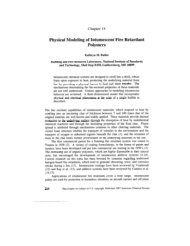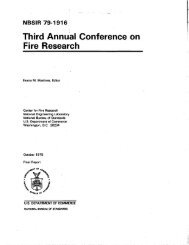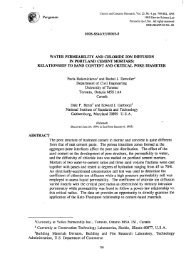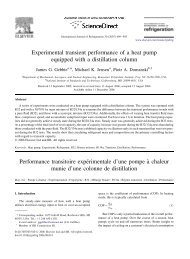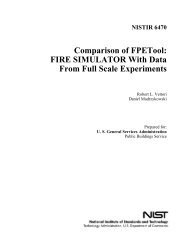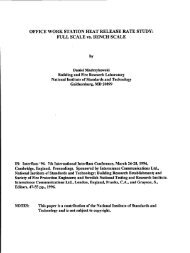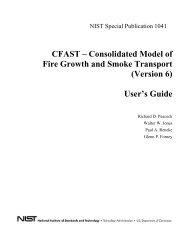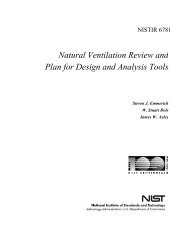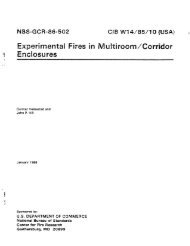Study of Technology for Detecting Pre-Ignition Conditions of ... - NIST
Study of Technology for Detecting Pre-Ignition Conditions of ... - NIST
Study of Technology for Detecting Pre-Ignition Conditions of ... - NIST
You also want an ePaper? Increase the reach of your titles
YUMPU automatically turns print PDFs into web optimized ePapers that Google loves.
Harwood, J. A.; Moseley, P. T.; Pea~ R; Reynolds, C..&<br />
Use<strong>of</strong> I.ow Power Carbon Monoxide Sensors to Provide Early Warning <strong>of</strong> Fire.<br />
Harwell Lab., Ox<strong>for</strong>dshire, UK<br />
CPSC-IAG95-1145<br />
Home ~lce, UK<br />
Fwe Safety Journal, Vol. 17, No. 6, 431-443, 1991.<br />
University <strong>of</strong> Duisburg. International Conference on Automatic Fre Detection “AUBE ‘89”, %b. September 26-28, 1989, Duk~b~ West<br />
Germany, LUCIGH., Editor, 433-447 pp, 1989.<br />
Harwood, J.; Reynolds, C.<br />
Development <strong>of</strong> New Fire Sensors.<br />
Home OfIice Fwe Research and Development Group, UK<br />
Fire Research News, Vol. 13, 14-15, Spring 1991.<br />
Hkrlemann, Andreas; Weimar, Udw Kmus, Gerolfj Schweizer-Berberich, MarkurLGoepel, Wolfgang<br />
Polymer-based sensor arrays and multicomponent analysis <strong>for</strong> the detection <strong>of</strong> hazardous organic vapours in the environment<br />
Univ <strong>of</strong> Tuebinge& Tuebinge~ Ger<br />
Proceedings <strong>of</strong> the EUROSENSORS VIJJConfkrenee. Part 1 Toulouse, Fr<br />
.ti Franc%M JnteqCentreNationalde la Recherche Scientitlqu% Commission <strong>of</strong> the EuropeanCommunities; InternationalSciences Foundation,<br />
et al<br />
Sensors and Actuators, B. Chemical v B26 n 1-3 pt 1 May 1995. p 126-134<br />
1995<br />
Kmgon, A. I. ; Myers, E. R ; Tutlle, B.<br />
FerroelectricThii Fihns II. MaterialsResearch Society Symposium proceedings Held in Boston, Massachusettson December 2-4, 1991. Volume<br />
243<br />
Materials Research Society, Pittsbur~ PA.<br />
NTIS Accession Nmnb- AD-A261 895/7<br />
1992 694p<br />
L& Yuanjti, Jiang, Zhufeng, Tao, Yueme~ Wu, Zhihong<br />
Novel catalytic gas sensor has long-life and low power consumption<br />
Inst <strong>of</strong> <strong>Pre</strong>cious Metals in Kumning, Kunming, China<br />
Sensor Review v 15 n 11995. p 22-24<br />
1995<br />
LdtorL C. D+ Conti, R S.; Tabacc& J. G.; Grace, R.<br />
Evacuation<strong>of</strong> a Nfic-Oxide-Compensated Carbon Monoxide Fwe Sensor.<br />
Bureau <strong>of</strong> Mines, Pittsburgh+PA<br />
IC 933% 14p. 1993.<br />
This U. S. Bureau <strong>of</strong> Mines report describes the resuk.s <strong>of</strong> two large-scale tests conducted to evaluate a prototype nitric oxide<br />
(NO)-compensated carbon monoxide (CO) fwe sensor, developed by Carnegie Mellon Research Institute(CMRI). In the te*s, small coal f~es<br />
were allowed to develop in the presence <strong>of</strong> diesel exhaust at relatively low ventilation airflows. These tests compared the response <strong>of</strong> the CMRI<br />
fue sensor with that<strong>of</strong> other fire sensors, inclutmg *e Bureau’s di*el-dkti*g smoke detector. Duringthetests, CO, NO, and smoke levels<br />
were continuously monitored in order to determine the sensor alarm times and gas levels as the fm developed. The data indkted that the<br />
NO-compensated CO fm sensor was capable <strong>of</strong> suppressing the CO produced by a diesel engine and that the sensor responded reliably to the<br />
CO produced ffom the test fwes. me tests aiso showed thatthe Bureau’s diesel-dkrirninating smoke detector alarmed earlierthanthe prototype<br />
NO-compmsated CO fue sensor.<br />
Moye, C. H.<br />
Development <strong>of</strong> a Fmt Approximation <strong>of</strong> a Design Method <strong>for</strong> Combustible Gas Detection Systems.<br />
Worcester Polytcchric InsL, MA<br />
TlresK, 99p. May 1991.<br />
This paper reviews the basic design objectives <strong>for</strong> the use <strong>of</strong> fixed combustible gas detection systems, reviews the state-<strong>of</strong>-t.be+utin<br />
combustible gas detection technology, and reviews criteria used m tie design and layout <strong>of</strong> tixed systems. A solution <strong>for</strong> sensor placement in<br />
anon-ventilated enclosure is presented. There is also a dkcussion regarding the development <strong>of</strong> a nationaIconsensus standard<strong>for</strong> the design and<br />
installation <strong>of</strong> combustible gas detection systems. There is no standard <strong>for</strong> the design and installation <strong>of</strong> combustible gas system> although<br />
standards<strong>for</strong> system components do exist.<br />
Munday, E. B.<br />
Chlor<strong>of</strong>luorocsrbon leak detection technology<br />
Oak Ridge K-25 Site, TN.<br />
69



